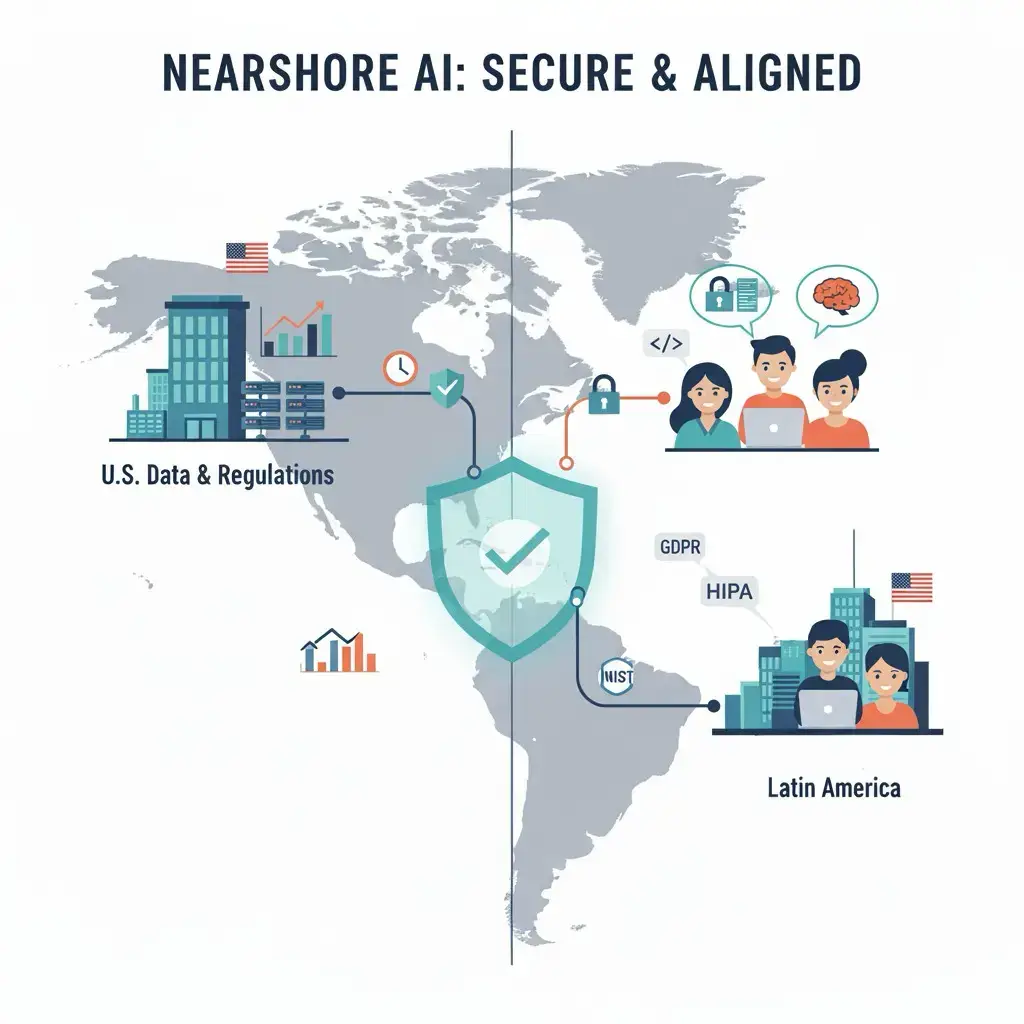Artificial intelligence is no longer an experimental add-on for regulated industries—it’s becoming the core of how financial firms detect fraud, how hospitals manage patient care, and how governments deliver services to citizens. As McKinsey’s 2024 State of AI report highlights, more than half of companies have already adopted AI in at least one function, and adoption rates in finance, healthcare, and public sector organizations are accelerating.
Yet in these industries, innovation walks hand-in-hand with regulation. Frameworks like HIPAA, GDPR, the NIST AI Risk Management Framework, and the emerging EU AI Act define strict boundaries for how data can be collected, stored, and processed. For leaders, the challenge is clear: how do you scale AI solutions while respecting cross-border compliance and mitigating risks inherent in outsourcing?
This is where nearshore AI development becomes a powerful alternative. Nearshore teams bring the speed and cost benefits of outsourcing while aligning more closely with the compliance expectations of regulated industries. The key is to ensure that compliance frameworks, remote team management, and cultural alignment aren’t afterthoughts, but are built into the operating model from day one.
Why Regulated Industries Need Nearshore AI Development.
AI is no longer optional in regulated industries. Banks utilize machine learning for anti-money laundering (AML) and know-your-customer (KYC) processes. Hospitals rely on predictive AI to manage patient data and optimize care delivery. Governments turn to AI for fraud detection, tax enforcement, and even city planning. In each case, compliance is non-negotiable.
Traditional offshore outsourcing often introduces headaches in these scenarios. Significant time zone gaps, cultural differences, and lower regulatory familiarity can slow development and create compliance blind spots. Nearshore teams, by contrast, offer three distinct advantages:
1. Proximity and time zone alignment. Collaboration between U.S. stakeholders and Latin American developers occurs in real-time, reducing communication lags.
2. Cultural affinity and English fluency. Shared communication norms and business culture lower the risk of misinterpretation in compliance-sensitive work.
3. Regulatory familiarity. Many Latin American countries work closely with U.S. and European firms and have adopted similar data protection and compliance standards.
As Deloitte notes, nearshoring has evolved into a strategic alternative, not simply a lower-cost option. For regulated industries outsourcing critical AI functions, this alignment makes nearshore teams particularly attractive.
The Compliance Challenge in AI Development.
Developing AI solutions is inherently complex; doing so in regulated environments that span borders is exponentially more challenging. Several compliance frameworks define the rules of the road:
• NIST AI Risk Management Framework (U.S.): Guidelines for trustworthy and transparent AI.
• EU AI Act (Europe): Classifies AI systems by risk and sets obligations accordingly.
• HIPAA (U.S.): Protects patient health information.
• GDPR (Europe): Defines strict rules on personal data collection, transfer, and consent.
• SOC 2: Audits organizational practices around security, availability, and confidentiality.
When AI development is distributed across multiple geographies, risks multiply. Each additional endpoint (a developer’s laptop, a testing environment, a third-party API) creates potential vulnerabilities. Data residency becomes another hurdle: European data may not legally be processed in certain jurisdictions unless specific safeguards (like Standard Contractual Clauses) are in place.
In short, cross-border compliance requires a proactive strategy, not reactive fixes.
Making Nearshore Teams Work in Regulated AI Projects.
Embedding Compliance into Nearshore Development.
Compliance cannot be tacked on at the end of a project. It must be baked into the software development lifecycle (SDLC):
• Privacy and security by design. Conduct privacy impact assessments before coding begins.
• Data handling protocols. Encrypt data at rest and in transit, anonymize sensitive records, and enforce role-based access.
• Third-party risk management. Vet every external tool, API, or vendor with compliance audits.
PwC’s work on Responsible AI and third-party risk management makes it clear that vendor and partner oversight is critical. One conclusion many organizations draw is that third-party risk is often among the most overlooked vulnerabilities in AI development.
Remote Team Management for Regulated AI.
Effective remote team management ensures compliance isn’t lost in translation. Leaders should establish:
• Oversight systems. Project management tools that integrate compliance checklists and audit trails.
• Traceability. Document every decision, code review, and model update for accountability.
• Secure collaboration. Identity and access management (IAM), audit logs, and multi-factor authentication must be standard.
As Deloitte highlights in its work on compliance modernization, visibility and traceability are essential to managing distributed teams, particularly in regulated environments.
Cultural and Operational Alignment.
Technical safeguards alone aren’t enough. Compliance is a cultural commitment. Nearshore developers must be trained not just in code, but in the compliance expectations of the industries they serve. Practical steps include:
• Regular cross-border workshops on HIPAA, GDPR, or SOC 2 expectations.
• Shared governance councils where compliance officers and developers align.
• Transparent communication channels that encourage developers to flag compliance concerns early.
When compliance is integrated into the team’s DNA, nearshore AI development becomes less about “outsourcing risk” and more about shared responsibility.
Lessons from the Field: How Regulated AI Projects Handle Compliance.
Based on real-world engagements in healthcare, fintech, and enterprise AI, several recurring patterns emerge when nearshore teams tackle compliance challenges. These lessons, drawn from industry practice, show how organizations navigate the balance between innovation and regulation.
Example 1: Healthcare AI project.
A U.S. healthcare provider partnered with a nearshore team to build a diagnostic AI system. The challenge was ensuring that patient data never left its legal jurisdiction. The solution was strict access controls, data anonymization, and region-locked environments. Lesson: Compliance can be maintained if the architecture is designed for data residency from the start.
Example 2: Fintech compliance.
A fintech company outsourced nearshore development of its AML/KYC system. Sensitive financial data had to be protected under SEC and GDPR rules. Developers worked within tokenized, sandbox environments where no raw customer data was exposed. Lesson: Creative technical solutions like tokenization enable compliance without slowing innovation.
Example 3: Enterprise Responsible AI governance.
A multinational deployed an enterprise AI system where regulators worried about algorithmic bias. The nearshore team integrated explainability features and compliance checkpoints into every sprint. Lesson: Embedding governance throughout the SDLC creates transparency that satisfies both regulators and end users.
These approaches underscore that nearshore teams are fully capable of delivering compliant AI solutions when frameworks, oversight, and cultural alignment are in place.
Building a Nearshore Compliance Framework that Scales.
One project is manageable; scaling to multiple teams across multiple jurisdictions requires structure. A nearshore development compliance framework should include:
• Flexible contracts. Allow for audits, termination rights, and shared liability clauses.
• Ongoing risk monitoring. Use automated dashboards and independent audits to measure compliance continuously.
• Scalable playbooks. Standardize processes across nearshore partners so lessons from one project apply to the next.
• Future-proofing. Regulations evolve—consider the EU AI Act or U.S. state-level AI bills. A framework that anticipates change will save time and cost later. This approach transforms compliance from a bottleneck into a competitive differentiator.
The Future of Nearshore Teams in Regulated AI.
Looking ahead, two forces are converging:
1. AI adoption will continue to expand. McKinsey’s research shows organizations embedding generative AI into core business functions at scale.
2. Regulatory scrutiny will intensify. Governments are drafting AI-specific governance laws to address risks of bias, misuse, and data privacy.
Nearshore teams are positioned not as cost-cutting measures but as strategic partners for companies in regulated industries. Their proximity, alignment, and agility make them ideal collaborators in the age of compliance-driven AI development.
Conclusion.
For leaders in regulated industries, the path forward is clear: innovation with AI cannot wait, but neither can compliance. Nearshore AI development offers a middle ground where speed and cost savings coexist with robust compliance practices.
When organizations embed compliance frameworks, enforce rigorous remote team management, and foster cultural alignment, nearshore teams can thrive even in the most regulated environments. The result isn’t just successful projects—it’s sustainable, scalable AI innovation.


